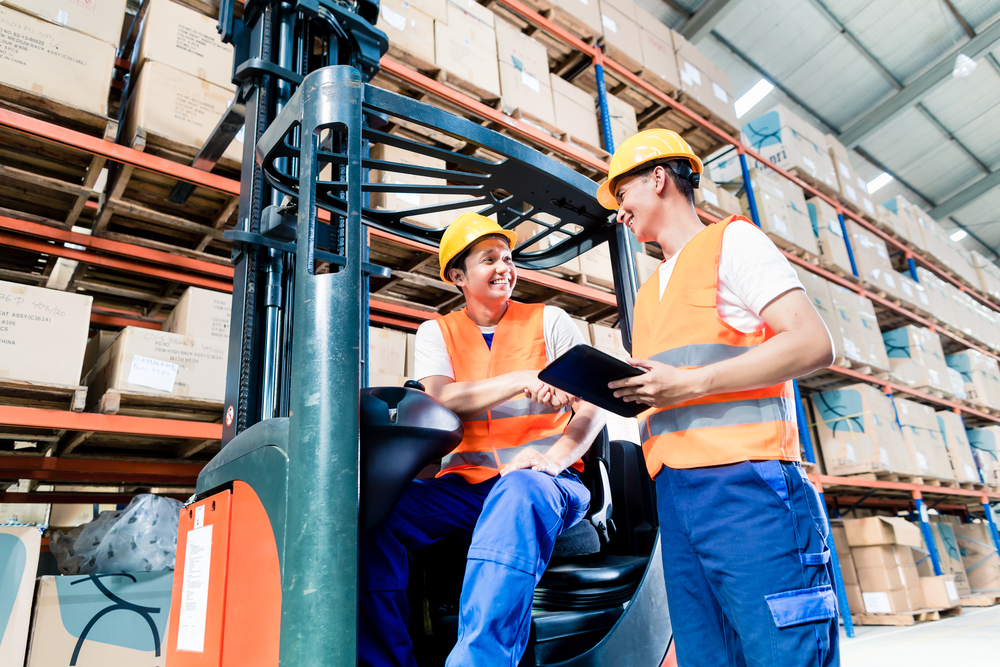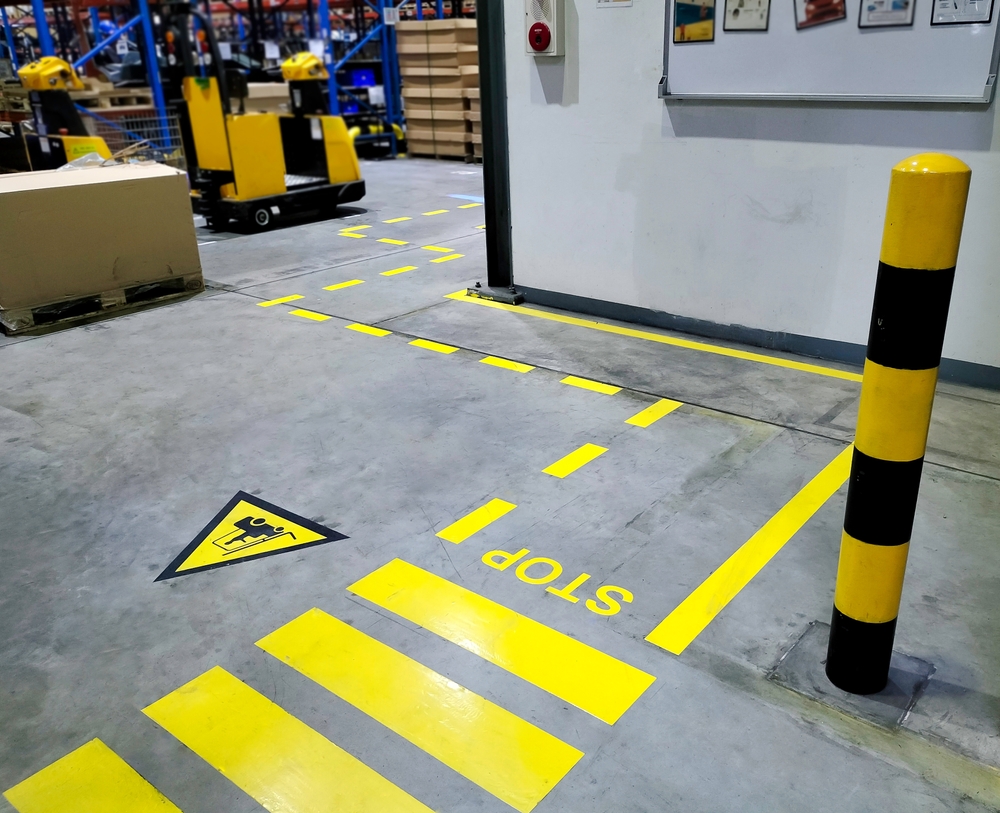Warehouses are among the busiest work environments in the industrial sector. This makes them one of the industries that need road paint the most.
Workers, forklifts, delivery trucks, and visitors often share the same space, creating a high risk for accidents if movement is not controlled. Clear and durable warehouse safety floor markings provide the visual guidance needed to reduce hazards, improve efficiency, and maintain compliance with workplace safety regulations.
This article examines the most important safety lines inside warehouses and explains why they are vital to safe and efficient operations.
Why Safety Markings Matter
In an environment where heavy equipment and people work side by side, assumptions can lead to costly mistakes. A forklift operator may cut across a walkway if lanes are not clearly defined, or workers may unknowingly block emergency exits if routes are not visibly marked. Warehouse safety lines eliminate uncertainty by:
- Preventing accidents through clear separation of people and vehicles.
- Improving operational flow by guiding traffic in predictable patterns.
- Supporting compliance with occupational health and safety regulations.
- Reducing downtime caused by collisions or workplace injuries.

Forklift Lanes
Forklifts are essential to warehouse operations, but also pose one of the greatest risks. Accidents involving forklifts can result in serious injuries, property damage, and operational delays.
Key Functions of Forklift Lane Markings
- Defining travel routes: Painted lanes ensure forklifts move in predictable paths, reducing the risk of sudden turns into pedestrian areas.
- Controlling traffic flow: Arrows and directional lines organize two-way traffic and prevent head-on collisions in narrow aisles.
- Improving efficiency: Clear lanes reduce congestion and allow operators to focus on safe handling of goods rather than navigating uncertain routes.
Best Practices
These line markings for warehouses and industrial zones should be wide enough to accommodate the turning radius of the equipment. Corners and intersections benefit from curved line markings or painted warning signs to minimize blind spots. In high-traffic areas, color coding creates instant recognition for operators.
Pedestrian Pathways
Workers, inspectors, and visitors often share warehouse space with moving machinery. Without designated walkways, pedestrians may take unpredictable routes, placing themselves at risk.
Key Functions of Pedestrian Pathway Markings
- Separating people from vehicles: Clearly marked walkways keep workers away from forklift routes.
- Directing safe passage: Pathways guide workers toward workstations, offices, rest areas, or exits without crossing high-risk zones.
- Enhancing visitor safety: External contractors or delivery drivers unfamiliar with warehouse operations can easily follow painted footpaths.
Best Practices
Green or white paint is commonly used for pedestrian walkways, often with solid lines and human figure symbols for clarity. Crosswalk-style markings are recommended at intersections where walkways cross forklift lanes. For added safety, pathways leading to emergency exits should connect seamlessly with exit route markings.

Fire Exits and Emergency Routes
When a fire breaks out, panic and confusion can spread just as fast as the flames. Visible fire exit markings and route lines provide calm, reliable direction, ensuring people know exactly where to go.
Key Functions of Fire Exit and Emergency Route Markings
- Maintaining clear access: Painted boundary lines prevent equipment or materials from blocking exits.
- Guiding evacuation: Directional arrows along emergency routes lead workers to the nearest safe exit.
- Meeting regulatory requirements: Both the Department of Labor and Employment (DOLE) and the Bureau of Fire Protection (BFP) mandate unobstructed and clearly visible fire exits.
Best Practices
Bright colors such as red or orange are often used, supplemented by text labels like “FIRE EXIT” or “KEEP CLEAR.” Routes should be reinforced with photoluminescent paint or reflective tapes to remain visible during power outages. Regular inspections are crucial to ensure safety lines in the warehouse remain unobstructed by pallets, trolleys, or machinery.
Loading and Unloading Zones
The loading dock is one of the most active and potentially hazardous areas in a warehouse. Trucks, forklifts, and workers all converge here to transfer goods.
Key Functions of Loading Zone Markings
- Defining vehicle positions: Marked bays ensure trucks park correctly, leaving adequate space for forklifts to maneuver.
- Indicating safe staging areas: Zones marked for pallet or cargo placement keep goods organized and prevent clutter in walkways.
- Managing risk: Visual boundaries reduce the chance of forklifts clipping walls, doors, or other vehicles.
Best Practices
Yellow or striped warehouse safety lines are typically used to highlight loading bays. No-parking zones should also be marked around doors to prevent obstruction. High-visibility chevrons or hazard stripes can alert operators to dock edges and prevent accidental falls.

Hazard and Restricted Areas
Certain parts of a warehouse carry higher risks and must be marked accordingly. These include areas near machinery, chemical storage, or electrical panels.
Key Functions of Hazard Area Markings
- Identifying danger zones: Painted warnings alert workers to areas with moving equipment, high voltage, or flammable materials.
- Restricting unauthorized access: Bold lines and signage discourage workers from entering restricted spaces.
- Reinforcing PPE requirements: Some markings may indicate where hard hats, goggles, or other protective gear must be worn.
Best Practices
Hazard areas are usually marked in red, orange, or black-and-yellow stripes. Diagonal hatch patterns are highly effective in signaling danger. Text labels such as “DANGER” or “AUTHORIZED PERSONNEL ONLY” provide added clarity.
Your Trusted Partner in Warehouse Safety
At Rua Seguridad, we understand that warehouse safety is more than just compliance. It is about protecting lives and keeping operations running smoothly. With years of experience in industrial and commercial projects, our team can help design and implement a floor marking system tailored to your facility.
We provide:
- Durable marking solutions that withstand heavy traffic and harsh conditions.
- Custom layouts designed around your unique workflow and safety needs.
- Expert recommendations on materials, colors, and maintenance schedules.
From forklift lanes to fire exits, Rua Seguridad ensures every warehouse safety floor marking serves its purpose: guiding people, controlling traffic, and minimizing risks.

Keeping Warehouses Risk-Free, One Safety Line at a Time
Safety markings in warehouses are not optional. They are an essential component of any well-managed warehouse.
By clearly defining forklift lanes, pedestrian pathways, fire exits, loading zones, and hazard areas, companies create a safer and more efficient environment. Beyond preventing accidents, these markings reinforce compliance with DOLE and BFP standards and foster a culture of safety that benefits every worker.
Warehouses that invest in well-planned, high-quality safety markings protect both their people and their productivity. Partnering with a knowledgeable provider like Rua Seguridad ensures that these critical details are executed with precision and durability.



